Understanding Performance Art
A person sits silently for hours. Another paints with their feet in a public plaza. A crowd is invited to join a simple ritual. Those are all performance art. It’s live, unpredictable, and often more about the idea than a finished object. If that sounds odd, it should — performance art wants you to feel, question, or act, not just look.
What performance art is
Performance art uses the body, actions, time, and place as the artwork. Unlike theater, it usually avoids a long script or clear plot. It can be planned down to the second or left open to chance. The work can be political, personal, funny, or shocking — sometimes all at once. Roots stretch from Dada and Futurism into Fluxus and the experimental scenes of the 1960s and 70s. Think Yoko Ono’s simple gesture pieces, Marina Abramović’s intense endurance works, or Chris Burden’s stunts that pushed limits. These moments changed how artists used presence and audience interaction.
Key things to know: the piece is often temporary, context matters (where and who is present), and documentation — photos or video — is only a record, not the full work. That’s why many performance pieces feel different in person than on screen.
How to watch or make performance art
As an audience member, be open. Sit with discomfort. Avoid filming everything; your phone can become a barrier between you and the moment. Read any notes from the artist or curator first — they give clues. Respect boundaries. If the artist asks you to join, do so with consent and clear rules. Ask questions after the piece. Learning from the artist or curator helps connect the idea to what you saw.
If you want to make performance art, start with one clear idea. What question are you asking? Use simple tools: your body, a single prop, one action repeated over time. Test it in a small space or with friends. Think about safety and consent for both you and any participants. Decide how you will document the piece — good photos or a short video matter if the work is temporary. Collaboration often improves performance art; another person can add an angle you didn’t see.
Practical checklist for creators: pick the message, choose the space, set rules for interaction, rehearse the timing, plan documentation, and prepare a short statement for viewers. That statement helps frame the piece without giving it all away.
Performance art can feel strange at first. That’s part of its power. It asks you to notice time, presence, and how people react. If you want more background, check related pieces on Fluxus and installation art to see how live actions connect with other experimental work. Seeing a few performances will make the ideas stick — and might change how you think about art altogether.

